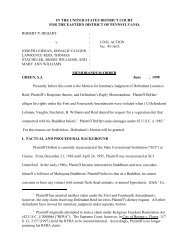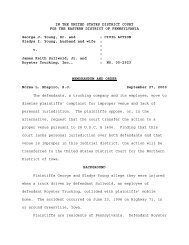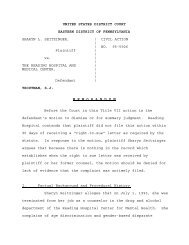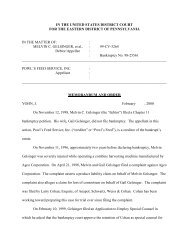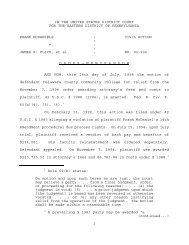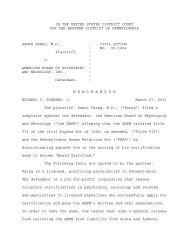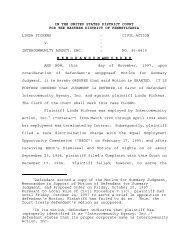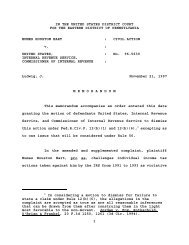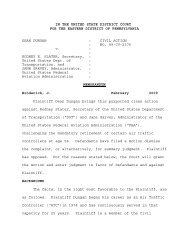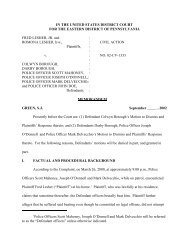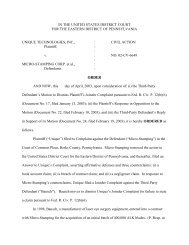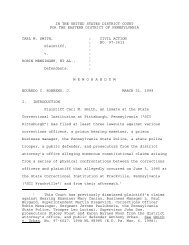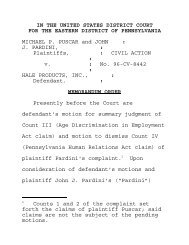Hartman Plastics - Eastern District of Pennsylvania
Hartman Plastics - Eastern District of Pennsylvania
Hartman Plastics - Eastern District of Pennsylvania
You also want an ePaper? Increase the reach of your titles
YUMPU automatically turns print PDFs into web optimized ePapers that Google loves.
IN THE UNITED STATES DISTRICT COURT<br />
FOR THE EASTERN DISTRICT OF PENNSYLVANIA<br />
______________________________<br />
:<br />
<strong>Hartman</strong> <strong>Plastics</strong>, Inc., :<br />
Plaintiff, : CIVIL ACTION<br />
: NO. 97-CV-2679<br />
v. :<br />
:<br />
Star International LTD-USA, :<br />
Defendant. :<br />
______________________________:<br />
:<br />
Star International LTD-USA, :<br />
Plaintiff, : CIVIL ACTION<br />
: NO. 97-CV-2734<br />
v. :<br />
:<br />
<strong>Hartman</strong> <strong>Plastics</strong>, Inc., :<br />
Defendant. :<br />
______________________________:<br />
McGlynn, J. September , 1998<br />
MEMORANDUM OF DECISION<br />
Before the court is Star International LTD-USA’s (“Star”)<br />
post-trial motion to alter or amend the judgment, or<br />
alternatively, for a new trial on damages. <strong>Hartman</strong> <strong>Plastics</strong>,<br />
Inc. (“<strong>Hartman</strong>”) opposes the motion. For the following reasons,<br />
Star’s motion will be denied.<br />
I. BACKGROUND<br />
<strong>Hartman</strong> is a manufacturer <strong>of</strong> foamboard located in Chester<br />
County, <strong>Pennsylvania</strong>. Star was <strong>Hartman</strong>’s exclusive distributor<br />
<strong>of</strong> foamboard in the Middle East. This dispute arises from a<br />
written Settlement Agreement, General Release, and Distribution<br />
Agreement ("the Agreement") reached between the parties on August<br />
12, 1996. The Agreement made Star the exclusive distributor <strong>of</strong>
<strong>Hartman</strong> foamboard in the Middle East for three and a half years.<br />
In that interval, Star had to order a specific number <strong>of</strong> <strong>Hartman</strong><br />
foamboard containers during a series <strong>of</strong> four specified time<br />
periods, beginning with a minimum <strong>of</strong> ten containers between<br />
August 15, 1996 and April 14, 1997.<br />
On April 9 or 10, 1997, Star placed an order for the minimum<br />
ten containers, its only order in the first period. <strong>Hartman</strong><br />
refused to fill the order on the belief that it was not genuine<br />
and Star would be unable to pay for the ten containers. <strong>Hartman</strong><br />
then filed suit against Star claiming fraud in the inducement <strong>of</strong><br />
the Agreement and breach <strong>of</strong> contract. Star counterclaimed<br />
against <strong>Hartman</strong> alleging breach <strong>of</strong> contract for refusing to fill<br />
the order.<br />
A trial was held from May 11 to 13, 1998, in which <strong>Hartman</strong><br />
sought to prove that it was entitled to refuse performance <strong>of</strong> the<br />
Agreement and Star sought damages for lost pr<strong>of</strong>its on the sale <strong>of</strong><br />
foamboard for the entire three-and-a-half year Agreement term. A<br />
jury returned a verdict by way <strong>of</strong> special interrogatories,<br />
finding: (1) <strong>Hartman</strong> was not entitled to refuse performance <strong>of</strong><br />
the Agreement on the ground <strong>of</strong> fraudulent inducement; (2) <strong>Hartman</strong><br />
was not entitled to refuse performance <strong>of</strong> the Agreement on the<br />
grounds that Star failed to exert its best efforts or act in good<br />
faith in performing its part <strong>of</strong> the agreement; (3) <strong>Hartman</strong><br />
breached the Agreement with Star; and (4) Star should be awarded<br />
2
$10,000 in damages for breach <strong>of</strong> the Agreement.<br />
On May 14, 1998, the court molded the jury’s verdict and<br />
entered a civil judgment in favor <strong>of</strong> Star and against <strong>Hartman</strong> in<br />
Civil Action No. 96-CV-2679, and in favor <strong>of</strong> Star and against<br />
<strong>Hartman</strong> in the amount <strong>of</strong> $10,000 in Civil Action No. 97-CV-2734.<br />
II. DISCUSSION<br />
Star seeks to alter or amend the judgment to enjoin <strong>Hartman</strong><br />
from refusing to honor the Agreement and to order that the end <strong>of</strong><br />
the term <strong>of</strong> the Agreement be extended from February 15, 2000 to<br />
March 15, 2001. If Star is not awarded that injunctive relief,<br />
it asks for a new trial on damages because the $10,000 jury award<br />
was grossly insufficient and against the weight <strong>of</strong> the evidence.<br />
A. Injunctive Relief for Star<br />
Star brings its motion to alter or amend the judgment under<br />
Federal Rule <strong>of</strong> Civil Procedure 59(e). A Rule 59(e) motion is<br />
appropriate “if the court in the original judgment failed to give<br />
relief on a certain claim on which it has found that the party is<br />
entitled to relief.” 11 Charles A. Wright & Arthur R. Miller,<br />
Federal Practice & Procedure § 2810.1 (1995). However, “[t]he<br />
Rule 59(e) motion may not be used to relitigate old matters, or<br />
to raise arguments or present evidence that could have been<br />
raised prior to entry <strong>of</strong> judgment.” Id. The grant <strong>of</strong> a Rule<br />
59(e) motion rests within the sound discretion <strong>of</strong> the trial<br />
court. Kiewit <strong>Eastern</strong> Co., Inc. v. L & R Const. Co., Inc., 44<br />
3
F.3d 1194, 1204 (3d Cir. 1995).<br />
A motion to alter or amend a judgment must be based on one<br />
<strong>of</strong> three grounds: (1) an intervening change in controlling law;<br />
(2) the availability <strong>of</strong> new evidence not available previously; or<br />
(3) the need to correct clear error <strong>of</strong> law or prevent manifest<br />
injustice. North River Ins. Co. v. Cigna Reinsurance Co., 52<br />
F.3d 1194, 1218 (3d Cir. 1995). Star has not asserted a change<br />
in law, the discovery <strong>of</strong> new evidence, or a clear error <strong>of</strong> law.<br />
The court therefore presumes Star’s motion is intended to prevent<br />
manifest injustice.<br />
1. Adequacy <strong>of</strong> Star’s Remedy at Law<br />
Star essentially seeks specific performance <strong>of</strong> the Agreement<br />
to continue as <strong>Hartman</strong>’s exclusive distributor in the Middle East<br />
until March 15, 2001. It argues that its legal claims were<br />
properly submitted to the jury, but that the court must now<br />
determine its claims for equitable relief. 1 Despite the fact<br />
that the Agreement made Star <strong>Hartman</strong>’s exclusive distributor in<br />
the Middle East until February 15, 2000, argues Star, the jury<br />
only awarded $10,000 in damages. “Clearly, the jury did not<br />
intend this award to reflect Star’s lost pr<strong>of</strong>its on sales<br />
throughout the remaining term <strong>of</strong> the Agreement. Rather, the jury<br />
1<br />
In both its complaint and counterclaim, Star requested a<br />
permanent injunction to prevent <strong>Hartman</strong> from refusing to fill<br />
Star’s orders and from violating the terms <strong>of</strong> the Settlement<br />
Agreement. See Star Mot. to Alter or Amend J. at 2.<br />
4
obviously followed the Court’s instruction that it should award<br />
damages for future lost pr<strong>of</strong>its only if they could be calculated<br />
with reasonable certainty.” Star Mem. <strong>of</strong> Law at 5-6. Star<br />
claims that it is entitled to equitable relief because the jury’s<br />
verdict <strong>of</strong> $10,000 shows that Star has no adequate remedy at law.<br />
<strong>Hartman</strong> responds that Star has already obtained an adequate<br />
legal remedy, and that “Star has maintained the adequacy <strong>of</strong> its<br />
legal remedy throughout this case.” <strong>Hartman</strong> Mem. <strong>of</strong> Law at 8.<br />
It points out: (1) Star argued that its damages were not<br />
speculative in its opposition brief to <strong>Hartman</strong>’s motion for<br />
partial summary judgment on count I <strong>of</strong> Star’s complaint, see<br />
<strong>Hartman</strong> Mem. <strong>of</strong> Law, Ex. E at 10, and (2) Star presented evidence<br />
<strong>of</strong> its monetary loss at trial and received an award from the<br />
jury.<br />
To obtain a permanent injunction, a plaintiff must prove he<br />
or she lacks an adequate remedy at law. International Union, UAW<br />
v. Mack Trucks Inc., 820 F.2d 91, 95 (3d Cir. 1987). “Where<br />
courts <strong>of</strong> law cannot afford an adequate or commensurate remedy in<br />
damages,” then legal remedies are inadequate. 11A Charles A.<br />
Wright & Arthur R. Miller, Federal Practice & Procedure § 2942<br />
(1995). 2 On May 27, 1997, the court denied Star's request for a<br />
2<br />
See also Bowen v. Massachusetts, 487 U.S. 879, 925 (1988)<br />
(Scalia, J., dissenting) (adequate remedy exists and “specific<br />
relief will be denied when damages are available and are<br />
sufficient to make the plaintiff whole”).<br />
5
preliminary injunction which would have forced <strong>Hartman</strong> to sell<br />
foamboard to Star, expressly finding that Star had an adequate<br />
remedy at law. Notwithstanding the jury’s $10,000 verdict, the<br />
court still believes Star received an adequate legal remedy at<br />
trial in the form <strong>of</strong> damages.<br />
Star interprets the $10,000 award to mean that the jury<br />
believed calculating damages over the entire life <strong>of</strong> the<br />
Agreement would be speculative. That interpretation is<br />
unwarranted. At trial, Star presented pro<strong>of</strong> <strong>of</strong> its damages for<br />
lost pr<strong>of</strong>its over the entire life <strong>of</strong> the Agreement. See May 12,<br />
1998 Trial Tr., 2 PM Session at 62-63. During the Agreement<br />
period, Star was required to order a minimum <strong>of</strong> 66 containers <strong>of</strong><br />
foamboard. Star presented evidence that it made an average<br />
pr<strong>of</strong>it <strong>of</strong> $5000 per container. Id. at 62. Therefore, Star<br />
argued, at a minimum, it would have earned $300,000 over the life<br />
<strong>of</strong> the Agreement. 3 May 13, 1998 Trial Tr. at 148. Star also<br />
claimed that it would have sold 50 more than the minimum sales<br />
requirement, totaling 116 containers during the Agreement<br />
period. 4 In closing, Star argued that “[u]nder the projection<br />
that Mr. <strong>Hartman</strong> made, if Star had been doing a good job,” it<br />
3<br />
It appears that counsel for Star made a mathematical<br />
error in its argument. 66 containers, at $5,000 pr<strong>of</strong>it per<br />
container, amounts to $330,000.<br />
4<br />
At $5,000 pr<strong>of</strong>it per container, Star’s earnings would<br />
have been $580,000 for 116 containers.<br />
6
could have sold 82 and a half containers during the Agreement<br />
term, resulting in lost pr<strong>of</strong>its <strong>of</strong> $412,500. Id. at 148-49.<br />
The jury plainly rejected those arguments. The evidence<br />
showed that only two <strong>of</strong> Star’s ten orders during the first period<br />
were firm, meaning the customer would pay for them at the time <strong>of</strong><br />
sale. See May 12, 1998 Trial Tr., AM Session at 14-18, 22, 91,<br />
95; see also May 12, 1998 Trial Tr., 2 PM Session at 21. The<br />
other eight were made on the understanding that the customer<br />
would only pay for the foamboard he actually sold. May 12, 1998<br />
Trial Tr., AM Session at 22-23. In addition, Star’s lack <strong>of</strong><br />
success in marketing <strong>Hartman</strong> foamboard during the first period<br />
(see id. at 38-39, 80; May 11, 1998 Trial Tr. at 112) could well<br />
have convinced the jury that Star would have been unsuccessful in<br />
meeting the 66-container minimum sales requirement. In view <strong>of</strong><br />
the evidence adduced at trial, the jury had a sufficient basis<br />
for awarding $10,000 in damages for the entire life <strong>of</strong> the<br />
Agreement.<br />
In addition, <strong>Hartman</strong> is correct that Star did not establish<br />
the elements <strong>of</strong> equitable relief at trial. Star concedes that<br />
“[t]he granting <strong>of</strong> equitable relief is a matter for the Court,<br />
based on the findings rendered by the jury.” Star Mem. <strong>of</strong> Law at<br />
8. But the jury was never presented with a case for equitable<br />
relief, and did not render a verdict addressing the elements<br />
which support the issuance <strong>of</strong> a permanent injunction.<br />
7
A prerequisite for permanent injunctive relief is a showing<br />
by the plaintiff that the court's exercise <strong>of</strong> equity jurisdiction<br />
is proper. Roe v. Operation Rescue, 919 F.2d 857, 867 n.8 (3d<br />
Cir. 1990). That is shown where: (1) the plaintiff has no<br />
adequate legal remedy; (2) the threatened injury is real, not<br />
imagined; and (3) no equitable defenses exist. Id.<br />
In this case, Star has not shown it had no adequate legal<br />
remedy. 5 To determine the legal adequacy <strong>of</strong> damages in a breach<br />
<strong>of</strong> contract action, the court considers: "(a) the difficulty <strong>of</strong><br />
proving damages with reasonable certainty, (b) the difficulty <strong>of</strong><br />
procuring a suitable substitute performance by means <strong>of</strong> money<br />
awarded as damages, and (c) the likelihood that an award <strong>of</strong><br />
damages could not be collected." Instant Air Freight Co. v. C.F.<br />
Air Freight, Inc., 882 F.2d 797, 800, 801-02 (3d Cir. 1989)<br />
(citing Restatement (Second) <strong>of</strong> Contracts § 360 (1981)).<br />
The damage remedy was adequate for Star under the first<br />
criterion. 6 As noted above, Star presented the jury with clear<br />
methods for calculating the amount <strong>of</strong> its damages over the life<br />
<strong>of</strong> the Agreement. The jury’s rejection <strong>of</strong> Star’s calculations <strong>of</strong><br />
5<br />
<strong>Hartman</strong> has also established that the equitable defense<br />
<strong>of</strong> election <strong>of</strong> remedies precludes post-trial injunctive relief<br />
for Star. See infra part II.A.2.<br />
6<br />
Because there is no record evidence concerning the<br />
difficulty <strong>of</strong> obtaining suitable substitute performance by means<br />
<strong>of</strong> money damages, or the possibility that damages could not be<br />
collected, the court does not consider those factors in<br />
determining the adequacy <strong>of</strong> Star’s legal remedy.<br />
8
its financial injury is immaterial to whether those damages were<br />
provable with reasonable certainty. The amount <strong>of</strong> damages<br />
claimed by Star was provable. At trial, however, Star failed to<br />
convince the jury <strong>of</strong> its appropriateness.<br />
2. Election <strong>of</strong> Remedies<br />
Star’s request for injunctive relief is also barred by the<br />
doctrine <strong>of</strong> election <strong>of</strong> remedies.<br />
In <strong>Pennsylvania</strong>, “[a]n election <strong>of</strong> remedies includes the<br />
deliberate and knowing resort to one <strong>of</strong> two inconsistent paths to<br />
relief.” West Middlesex Area Sch. Dist. v. Commonwealth, Pa.<br />
Labor Relations Bd., 423 A.2d 781, 783 (Pa. Commw. Ct. 1980).<br />
“[T]he adoption, by an unequivocal act, <strong>of</strong> one <strong>of</strong> two or more<br />
inconsistent remedial rights has the effect <strong>of</strong> precluding a<br />
resort to others.” Wedgewood Diner, Inc. v. Good, 534 A.2d 537,<br />
538 (Pa. Super. Ct. 1987) (quoting “Election: Rescission or<br />
Damages,” 40 A.L.R. 4th 627, 630-31). “[T]o be inconsistent the<br />
remedies in question must be different means <strong>of</strong> adjudicating the<br />
same issues.” West Middlesex Area Sch. Dist., 423 A.2d at 783-<br />
84. A party makes a conclusive election or remedies which will<br />
bar later resort to an inconsistent remedy when: (1) the party<br />
knows his rights, (2) has carried his case to a conclusion, and<br />
(3) has obtained a decision on the issues involved. Wedgewood<br />
Diner, 534 A.2d at 539 (citing 25 Am. Jur. 2d Election <strong>of</strong><br />
Remedies § 19).<br />
9
In this case, damages for the entire Agreement term and<br />
specific performance are merely different means <strong>of</strong> adjudicating<br />
the same issue, i.e., the affirmative relief due Star as a result<br />
<strong>of</strong> <strong>Hartman</strong>’s breach <strong>of</strong> the Agreement. As such, they are<br />
inconsistent remedies. 7 See West Middlesex Area Sch. Dist., 423<br />
A.2d at 783-84. Remedies are also inconsistent when “a double<br />
recovery would result.” 25 Am. Jur. 2d Election <strong>of</strong> Remedies § 17<br />
(1996); see also Myshko v. Galanti, 309 A.2d 729, 731-32 (Pa.<br />
1973) (disallowing equity suit for recovery <strong>of</strong> business sold<br />
where seller had already brought action at law to recover full<br />
contract price for sale). The damage award Star received at<br />
trial covered <strong>Hartman</strong>’s breach <strong>of</strong> the Agreement 8 after Star<br />
7<br />
Additionally, “[w]hile there is contrary authority, it<br />
has been held that an action for damages upon breach <strong>of</strong> contract<br />
and a suit for the specific performance <strong>of</strong> the contract are<br />
inconsistent remedies. Therefore, an action for damages for<br />
breach <strong>of</strong> contract may bar a later suit for specific performance<br />
<strong>of</strong> the same contract.” 25 Am. Jur. 2d § 24 (1996). In its<br />
discussion <strong>of</strong> inconsistent remedies, the Restatement <strong>of</strong> Contracts<br />
takes the same view: “the remedy <strong>of</strong> specific performance or an<br />
injunction and that <strong>of</strong> damages for total breach <strong>of</strong> contract are<br />
inconsistent.” Restatement (Second) <strong>of</strong> Contracts § 378 cmt. d<br />
(1981).<br />
8<br />
The jury interrogatories included two questions dealing<br />
with <strong>Hartman</strong>’s breach <strong>of</strong> the Agreement:<br />
3. Do you find that <strong>Hartman</strong> <strong>Plastics</strong>, Inc.,<br />
breached its agreement with Star<br />
International LTD-USA?<br />
4. What amount <strong>of</strong> damages do you award to<br />
Star International LTD-USA for <strong>Hartman</strong><br />
<strong>Plastics</strong>, Inc.’s breach <strong>of</strong> the Agreement?<br />
10
equested damages for the entire contract period. Star’s request<br />
for specific performance would therefore give it the full benefit<br />
<strong>of</strong> the Agreement for which it has already recovered damages -- a<br />
double recovery.<br />
Star points to the Restatement (Second) <strong>of</strong> Contracts § 378,<br />
which describes the doctrine <strong>of</strong> election among remedies as<br />
requiring not only that the remedies be inconsistent, but that<br />
“the other party materially change[] his position in reliance on<br />
the manifestation” <strong>of</strong> the choice <strong>of</strong> remedy. Restatement (Second)<br />
<strong>of</strong> Contracts § 378 (1981). Because <strong>Hartman</strong> has not materially<br />
changed its position as a result <strong>of</strong> Star’s decision to pursue<br />
damages, Star argues the election <strong>of</strong> remedies doctrine does not<br />
bar injunctive relief. This argument fails for the simple reason<br />
that <strong>Pennsylvania</strong> has not adopted the second prong <strong>of</strong> the<br />
Restatement rule requiring a material change <strong>of</strong> position. The<br />
<strong>Pennsylvania</strong> cases instead focus solely on the inconsistency <strong>of</strong><br />
the remedies sought, and make no mention <strong>of</strong> material change in<br />
position as having any bearing on the election <strong>of</strong> remedies<br />
doctrine. See, e.g., Boyle v. Odell, 605 A.2d 1260, 1265 (Pa.<br />
Super. Ct. 1992); Smith v. Brink, 561 A.2d 1253, 1255 (Pa. Super.<br />
Ct. 1989); Wedgewood Diner, Inc. v. Good, 534 A.2d 537, 538 (Pa.<br />
Super. Ct. 1987); West Middlesex Area Sch. Dist. v. Commonwealth,<br />
Jury Interrogatories 3 & 4.<br />
11
Pa. Labor Relations Bd., 423 A.2d 781, 783 (Pa. Commw. Ct. 1980).<br />
As a result, Star’s election to pursue damages for total<br />
breach <strong>of</strong> the Agreement bars post-trial injunctive relief.<br />
B. New Trial on Damages<br />
Star alternatively contends that the jury award was grossly<br />
insufficient and against the substantial weight <strong>of</strong> the evidence,<br />
necessitating a new trial on damages under Rule 59(a). 9<br />
A Rule 59(a) motion for a new trial is addressed to the<br />
sound discretion <strong>of</strong> the trial court. Wagner v. <strong>Pennsylvania</strong> R.<br />
Co., 282 F.2d 392 (3d Cir. 1960). In reviewing such a motion,<br />
the court must view the evidence in the light most favorable to<br />
the non-moving party. See Moyer v. SEPTA, Civ. A. No. 89-7836<br />
1991 WL 111092, at *2 (E.D. Pa. June 17, 1991) (citing Russell v.<br />
Monongahela Railway Co., 159 F. Supp. 650, 655 (W.D. Pa.), aff'd,<br />
262 F.2d 349 (3d Cir. 1958)). To constitute proper grounds for<br />
granting a new trial, an error, defect, or other act must affect<br />
the substantial rights <strong>of</strong> the parties. Fed. R. Civ. P. 61.<br />
Star contends that a jury award <strong>of</strong> only $10,000 for total<br />
breach <strong>of</strong> the Agreement is clearly against the substantial weight<br />
<strong>of</strong> the evidence. New trials because the verdict was against the<br />
clear weight <strong>of</strong> the evidence "are proper only when the record<br />
9<br />
Rule 59(a) allows the grant <strong>of</strong> a new trial “on all or<br />
part <strong>of</strong> the issues ... in an action in which there has been a<br />
trial by jury, for any <strong>of</strong> the reasons for which new trials have<br />
heret<strong>of</strong>ore been granted at law in the courts <strong>of</strong> the United<br />
States." Fed. R. Civ. P. 59(a).<br />
12
shows that the jury's verdict resulted in a miscarriage <strong>of</strong><br />
justice or where the verdict, on the record, cries out to be<br />
overturned or shocks our conscience." Williamson v. Consolidated<br />
Rail Corp., 926 F.2d 1344, 1353 (3d Cir. 1991). Moreover, a new<br />
trial based on an inadequate verdict is appropriate "only if the<br />
proceedings have been tainted by appeals to prejudice or if the<br />
verdict, in light <strong>of</strong> the evidence, is so unreasonable that it<br />
would be unconscionable to permit it to stand". New Market<br />
Invest. Corp. v. Fireman's Fund Ins. Co., 774 F. Supp. 909, 917<br />
(E.D. Pa. 1991) (quoting 11 Wright & Miller, Federal Practice &<br />
Procedure § 2807). Whether or not the trial judge agrees or<br />
disagrees with the jury's verdict, the verdict must be upheld if<br />
it is supported by a "minimum quantity <strong>of</strong> evidence from which a<br />
jury might reasonably [decline to] afford relief." Ford Motor<br />
Co. v. Summit Motor Prods., Inc., 930 F.2d 277, 290 (3d Cir.<br />
1991).<br />
The jury’s $10,000 award was not against the substantial<br />
weight <strong>of</strong> the evidence. Star had the burden <strong>of</strong> proving the<br />
amount <strong>of</strong> its damages at trial. The jurors evaluated the<br />
credibility and weight <strong>of</strong> the parties’ evidence, and made their<br />
findings accordingly. Given Star’s relative lack <strong>of</strong> success in<br />
marketing <strong>Hartman</strong> foamboard during the first Agreement period, a<br />
$10,000 jury award for total breach does not strike the court as<br />
a miscarriage <strong>of</strong> justice or shocking to the conscience. Another<br />
13
factfinder may have arrived at a different award amount.<br />
However, “[t]he mere fact that neither the plaintiff nor the<br />
Court has been able to mathematically deduce how the jury arrived<br />
a such a figure does not mandate that the jury's verdict should<br />
be overturned or a new trial awarded by this Court.” New Market<br />
Invest. Corp., 774 F. Supp. at 917.<br />
Star’s alternative motion for a new trial on damages is<br />
therefore denied.<br />
III. Conclusion<br />
For the foregoing reasons, Star’s motion to alter or amend<br />
the judgment, or alternatively for a new trial on the issue <strong>of</strong><br />
damages, is denied.<br />
14



